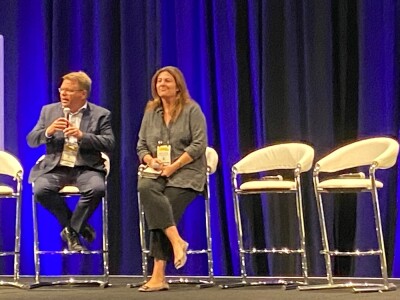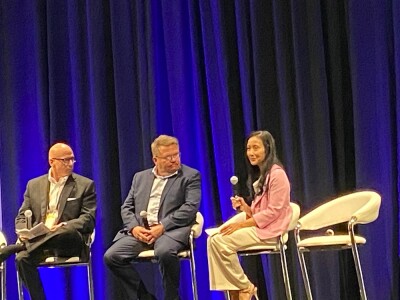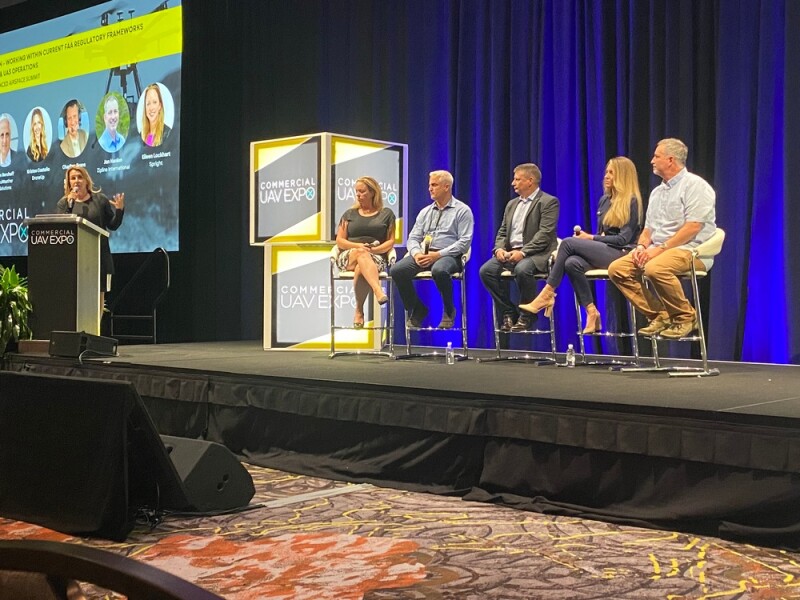On Wednesday at the Commercial UAV Expo at Caesar’s Forum in Las Vegas, a two-part Advanced Airspace Summit was held, looking at the current gap that exists between the crewed and uncrewed aviation spaces and the paths needed to bring the two sides together and advance the space as a whole. The extensive sessions covered everything from where the industry stands right now, the expected evolution of the technology to help bridge this gap, the necessary regulatory changes, and challenges the industry can expect to face in the coming years.
Toni Drummond of Titan Aviation has said regarding the importance of collaboration between everyone in the airspace industry, crewed and uncrewed, “The next revolution of sustainable aviation will depend on all stakeholders working together to develop solutions that will carry us directly into the future.”
The summit started with an address delving into what the future of airspace could look like, and how the sUAS community works with other stakeholders to enable a safe and open sky for everyone. James Grimsley and Adrienne Lindgren spoke about what the future skies will look like, what the security ramifications of the future ecosystem could look like, how to encourage cities to embrace this future, and so much more.

During the conversation, Lindgren said of the need to change how we talk about public acceptance, “For a long time we talked about community engagement from the lens of public acceptance, which to me connotes that we’re tolerating new aircraft and variation technology. Whereas, I think we need to flip the script and think about these business objectives.”
Grimsley did report in his experience that public acceptance is improving. He told the audience, “We’re seeing something that surprised me, as we’ve seen a major shift in how the public sees technology. The climate now is much different than 10 years ago.”
After that, a panel discussion led by Drummond, and also including Jon Damush, Eileen Lockhart, Erin Roesler, and Abby Smith, came together to talk about the complicated process of cultivating public trust in the airspace by further integrating the crewed and uncrewed aircraft spaces as well as working with regulations in place. Among the topics hit on by the panel were the state of this space today and the existing challenges and opportunities, currently available enabling technologies, currently regulatory pathways, and more.
Speaking about how to cultivate that public trust, Damush said, “Addressing the safety component and the public's perception of safety is absolutely critical to us gaining the public acceptance that then generates the groundswell of support, and pressure in some cases, through our lawmakers to get the changes made that need to happen.”
Another panel then came together, this one moderated by Sarasina Tuchen, USDOT’s Highly Automated Systems Safety Center of Excellence and also including Grimley and the FAA’s Frank McIntosh, to further discuss present drone corridors and how they’ll help define the future of airspace. The fascinating discussion touched on topics like how corridor development is progressing in Oklahoma where Grimley operates, the importance from the FAA’s perspective to start working now on what’s coming in the future, and the road towards urban AAM systems.

Following a quick break, the summit picked back up, moving a bit away from the idea of cultivating public trust to looking more closely at the regulatory and operational frameworks which will be necessary in the AAM space moving forward. The second half of the summit kicked off with a presentation from Ken Stewart, NUAIR and Jason Terreri, Syracuse International Airport, in which they discuss what the state of New York is doing today to prepare for the future, and why it’s so important to get that planning underway now.
That presentation was then followed by a panel, again led by Drummond along with Don Berchoff, Kirsten Costello, Charlton Evans, Jon Henlon, and Lockhart, this time featuring in-depth discussions on current FAA regulations in place and how professionals can work within these regulations to move the industry forward. They discuss the oft-cited obstacles created by regulations, and the planning and understanding needed to set up success in the future. Additionally, the panel looked at where things stand today with Part 107, and how, if at all, Part 108 could change things for stakeholders, among other conversations regarding the current and future regulatory landscapes.
Talking about changes in attitudes within the industry, Costello said, “We’ve really shifted into this culture of Yes, how can we do it?”
Finally, the summit concluded with a panel led by Dawn Zoldi of P3 Tech Consulting along with Damush, Ed De Reyes, and Josh Olds, with these experts coming together to talk through the framework that is needed to allow UAS business to thrive and provide sustainable alternatives to communities. While some of that framework already exists as OEMs and manufacturing partners, the panel discusses what needs to happen to bring this together in a way that makes sense. The conversation covers things like what is being done to enhance public acceptance for drones and eVTOL vehicles, when we can expect to see air taxi services begin, how OEMs are responding to market demands, and more.
Talking about the need for inter-industry collaboration if we’re going to move the space of Advanced Airspace Mobility forward, Damush summed things up nicely, saying, “The bottom line is: to go faster we've got to share. We have to share experiences, we have to share data, we have to operate, because none of us makes any money in the space until there is a space. We’ve got to create that space first.”















Comments